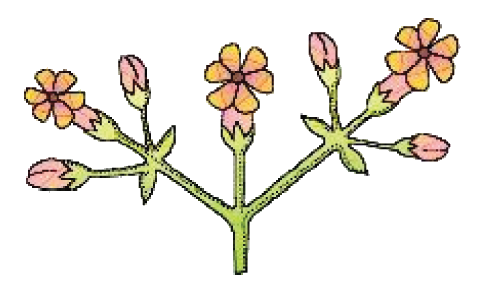Which inflorescence has biparous cyme ending in uniparous cymes
cyathium
verticillaster
hypanthodium
strobile
The correct Answer is:b
Step-by-Step Solution:
1. Understanding the Question: The question asks which type of inflorescence has a biparous cyme that ends in uniparous cymes. We need to identify the correct option from the given choices.
2. Identifying the Options: The four options provided are:
- Option 1: Seapium
- Option 2: Verticillaster
- Option 3: Hypanthodium
- Option 4: Strobile
3. Analyzing Each Option:
- Option 1: Seapium: This is a type of cymose inflorescence that typically appears as a single flower surrounded by bracts. It does not fit the description of having a biparous cyme ending in uniparous cymes.
- Option 2: Verticillaster: This inflorescence is characterized by clusters of sessile or subsessile flowers that are borne on a biparous cyme (dichasial) and end in uniparous cymes (monocasial). This matches the requirement of the question.
- Option 3: Hypanthodium: This inflorescence has a fleshy receptacle that forms a hollow cavity with flowers developing on the inner wall. It does not fit the description of biparous cymes ending in uniparous cymes.
- Option 4: Strobile: This is a type of spike where each flower is born in the axil of persistent bracts. It does not match the criteria given in the question.
4. Conclusion: After analyzing all the options, the correct answer is Option 2: Verticillaster, as it is the only inflorescence that has a biparous cyme ending in uniparous cymes.
---
- Option 1: Seapium
- Option 2: Verticillaster
- Option 3: Hypanthodium
- Option 4: Strobile
- Option 1: Seapium: This is a type of cymose inflorescence that typically appears as a single flower surrounded by bracts. It does not fit the description of having a biparous cyme ending in uniparous cymes.
- Option 2: Verticillaster: This inflorescence is characterized by clusters of sessile or subsessile flowers that are borne on a biparous cyme (dichasial) and end in uniparous cymes (monocasial). This matches the requirement of the question.
Topper's Solved these Questions
- INFIORESCENCEBOOK - DINESH PUBLICATION ENGLISHCHAPTER - INFIORESCENCEEXERCISE - check your grasp
10 Videos
- HUMAN REPRODUCTIONBOOK - DINESH PUBLICATION ENGLISHCHAPTER - HUMAN REPRODUCTIONEXERCISE - MCQ
770 Videos
- INTRODUCTION BOOK - DINESH PUBLICATION ENGLISHCHAPTER - INTRODUCTION EXERCISE - CYG
10 Videos
Similar Questions
Knowledge Check
Assertion:Thy cymose type of inflorescence has limited growth.
Reason:In cymose inflorescence the main axis terminates in a flower.AIf both assertion and reason are true and reason is the correct explanation of assertion.BIf both assertion and reason are true but reason is not the correct explanation of assertion.CIf assertion is true but reason is false.DIf assertion and reason are false.Which one of the following inflorescences is found in sunflower ?
ACapitulumBCyathiumCPanicleDSpadix
multiparous cyme occurs in
View SolutionWhich type of inflorescence is shown below?

View Solutionwhich type of inflorescence occurs in ficus
View Solutiona type of fruit in which entire inflorescence is Converted into a fruit is called
View Solutiondichasial cyme occurs in
View SolutionIn which type of inflorescence the flowers are borne in a basipetal order
View Solution
